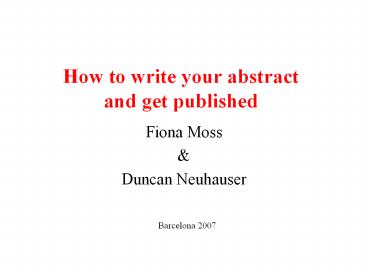How to write your abstract and get published - PowerPoint PPT Presentation
1 / 24
Title:
How to write your abstract and get published
Description:
How to write your abstract. and get published. Fiona Moss ... A research paper? A review? A 'How To Do It?' An opinion/view point? A letter? .etc etc etc . – PowerPoint PPT presentation
Number of Views:116
Avg rating:3.0/5.0
Title: How to write your abstract and get published
1
How to write your abstractand get published
- Fiona Moss
- Duncan Neuhauser
Barcelona 2007
2
Background
- There is a lot of good QI work out there
- It should be shared/communicated
- Writing is way of communication and
- Publication would help others
- Many people get stuck with writing
- Formats in journals often unhelpful
- Two editors who want to help.
3
Aims of this Session
- To show that writing about your work is
possible, can help your thinking and can be fun - For you to start to write an abstract about
your work - To encourage you to finish it and go onto to
write more
4
Objectives
- Learn about writing as a process
- Use a structure for writing about QI
- Encourage you think about what others could
learn from your work - Hear others stories of QI work
5
Format of this seminar
- Practical
- Fun
- Informative
- Interactive session
- BRIEF!!
6
Why bother to write well?
- To communicate your work well
- For clarity and accuracy of your message
- To engage and stimulate your readers
- To help you reflect on your work
- Because it can be enjoyable and fun
7
Reasons for not writing
- Difficulty knowing where to start
- Not knowing how to start
- Anxiety about writing skills
- Lack of confidence no assessment of writing
skills on health related courses - Writing is a gift
- Etc, etc.....
8
Getting down to writing
- Story
- Structure
- (Style)
9
Your story
- Think about a quality improvement work/project
of your own that you would like to share with
others - Describe it by writing about it in a just
paragraph or two. - Get it down to its basics
10
Now just who is this story for?
- READERS.
- So.
- Who are these readers???
11
Who are your readers?
- Editors?
- Reviewers?
- Not primarily..
- Who do you want to know about your work?
12
Who are your readers?
- Director of nursing/medical director/CEO??
- Colleagues/peers - doctor/nurse/therapist
- Your boss, your team, your students
- Your funding agency
- Your clients/local population
- Etc
13
Now find out about your story from a reader
- In pairs read your short description of your QI
work and ask your colleague to report - What is the story?
- What are the messages?
- What do they really want to know?
- What do they think is missing?
14
Now revise your description of your QI work
- In the light of the input from your reader
- Revise your brief description of your quality
improvement work - Make sure that you make the main messages clear.
15
You should write for your readers as they are
your customers!
16
Writing quality improvement papers finding a
structure
- Structure can help with the process of writing
- Use it as an aide memoir
- Make sure that you use the structure appropriate
for the journal and article type
17
Structure finding a form
- Standard structure helps writing
- Structure provides a logical sequence
- Must contain the story within it
- Setting objectives for the paper is important
- Continuity between sections is important
- Link back to objectives throughout
- End should connect with beginning ie discussion
must relate to introduction
18
First what sort of paper reflects your work?
- A quality improvement report?
- A research paper?
- A review?
- A How To Do It?
- An opinion/view point?
- A letter?
- .etc etc etc .....
19
Quality improvement reports check essentials?
- Is it about improving the quality of care?
- Does it have a message relevant to improving the
quality or safety of patient care? - Does it describe changes that improve patient
care? Is the evidence robust? - Is the message generalisable? What is in it for
others to learn?
20
Quality improvement reports
- Not necessarily completely original
- Must have a message for others
- Be explicit about context
- If change has occurred - how did you manage it
and sustain it ? - Organisational changes - important
- Interpersonal interactions - important
- Real message may lie in difficulties
- Progress may not be linear
- Be clear about messages
21
Structure for quality improvement reports
- Standard structure for research papers . IMRaD
- Introduction/Methods/Results and/Discussion
- Perhaps not very helpful for QI work
- QIR structure should reflects the cyclical
nature of QI and enable expression of process of
change and re-assessment and looks for lessons
22
Structure for quality improvement reports
- The context
- Outline of problem (patient centred)
- Key measures of improvement
- Assessment - methods result of assessment
- Strategy for change
- Effects of change - reassessment
- Next steps - lessons learnt - message
23
Now write that abstract
- Use the 2 paragraphs you wrote about your
quality improvement report , remember the input
from your reader - Revise it using the structure provided
24
Writing QI Reports
- Does this help?
- Could you convey your messages using this
structure? - What are the problems?
- Could you write your story for your reader?































